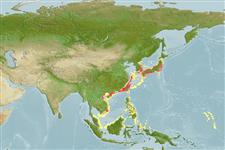>
Tetraodontiformes (Puffers and filefishes) >
Tetraodontidae (Puffers) > Tetraodontinae
Etymology: Takifugu: A Japanese word with several meanings; taki = waterfall + fugu = fish; it could be also understood as taki = to be cooked in liquid + fugu = a venomous fish.
More on author: Richardson.
Environment: milieu / climate zone / depth range / distribution range
Écologie
marin démersal. Subtropical
Northern West and Northwest Pacific: Northern South China Sea from Viet Nam, Yellow Sea and East China Sea.
Taille / Poids / Âge
Maturity: Lm ? range ? - ? cm
Max length : 30.0 cm SL mâle / non sexé; (Ref. 42715)
Gonad, blood, skin, flesh and liver toxic (Ref. 42715).
Life cycle and mating behavior
Maturities | Reproduction | Spawnings | Egg(s) | Fecundities | Larves
Yamada, U., 2002. Tetraodontidae. p. 1418-1431. In T. Nakabo (ed.). Fishes of Japan with pictorial keys to the species (second edition). Tokai University Press, 1749 p. (Ref. 42715)
Statut dans la liste rouge de l'IUCN (Ref. 130435)
Menace pour l'homme
Poisonous to eat (Ref. 42715)
Utilisations par l'homme
Outils
Articles particuliers
Télécharger en XML
Sources Internet
Estimates based on models
Preferred temperature (Ref.
123201): 16.1 - 28.5, mean 25.3 °C (based on 174 cells).
Phylogenetic diversity index (Ref.
82804): PD
50 = 0.5000 [Uniqueness, from 0.5 = low to 2.0 = high].
Bayesian length-weight: a=0.02291 (0.00967 - 0.05425), b=2.90 (2.72 - 3.08), in cm total length, based on LWR estimates for this Genus-body shape (Ref.
93245).
Niveau trophique (Ref.
69278): 3.4 ±0.3 se; based on size and trophs of closest relatives
Résilience (Ref.
120179): Haut, temps minimum de doublement de population inférieur à 15 mois (Preliminary K or Fecundity.).
Fishing Vulnerability (Ref.
59153): Low to moderate vulnerability (27 of 100).
